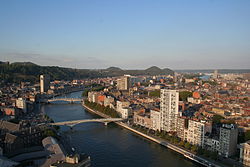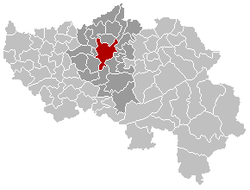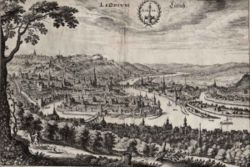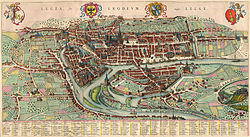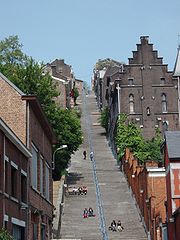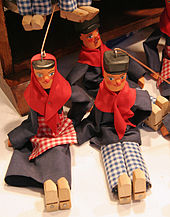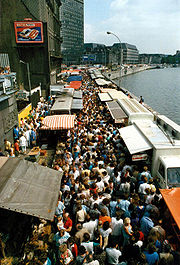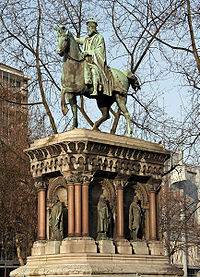- Liège
-
This article is about the Belgian city. For other uses, see Liège (disambiguation).
Liège 
Flag
Coat of armsLocation in Belgium Coordinates: 50°38′N 05°34′E / 50.633°N 5.567°E Country Belgium Region Wallonia Community French Community Province Liège Arrondissement Liège Government – Mayor Willy Demeyer (PS) – Governing party/ies PS – cdH Area – Total 69.39 km2 (26.8 sq mi) Population (1 January 2010)[1] – Total 192,504 – Density 2,774.2/km2 (7,185.2/sq mi) Demographics – Foreigners 16.05% (7 January 2005) Postal codes 4000–4032 Area codes 04 Website www.liege.be Liège (French pronunciation: [ljɛːʒ]; Dutch: Luik, [lœyk] (
 listen); Walloon: Lidje; German: Lüttich; Latin: Leodium; until 17 September 1946[2][3][4] the city's name was written Liége, with the acute accent instead of a grave accent) is a major city and municipality of Belgium located in the province of Liège, of which it is the economic capital, in Wallonia, the French-speaking region of Belgium.
listen); Walloon: Lidje; German: Lüttich; Latin: Leodium; until 17 September 1946[2][3][4] the city's name was written Liége, with the acute accent instead of a grave accent) is a major city and municipality of Belgium located in the province of Liège, of which it is the economic capital, in Wallonia, the French-speaking region of Belgium.The city is situated in the valley of the Meuse River, near Belgium's eastern borders with the Netherlands and Germany, where the Meuse meets the Ourthe. It is in the former sillon industriel, the industrial backbone of Wallonia. The Liège municipality includes the former communes of Angleur, Bressoux, Chênée, Glain, Grivegnée, Jupille-sur-Meuse, Rocourt, and Wandre.
The city is the principal economic and cultural centre of Wallonia. Liège is, with 194,054 inhabitants as of 1 May 2009, the second most populous city in Wallonia, after Charleroi.[5] The metropolitan area, including the outer commuter zone, covers an area of 1,879 km2 and has a total population of 749,110 as of 1 January 2008.[5][6] This includes a total of 52 municipalities, a.o. Herstal and Seraing, and ranks as the third most populous in Belgium, after Brussels and Antwerp.[6]
Contents
Etymology
Liège's Latin form, Leodium, has the Germanic word leod, meaning "people", as its origin. Compare archaic Dutch lui(den), lieden ("people"), Old English lēod (English lede "people"), Modern German Leute ("people"), Norwegian dialectal lyd ("people"). Also related are Russian люди (ljúdi) and Hindi loagh, both meaning "people".
History
Early Middle Ages
Although settlements already existed in Roman times, the first references to Liège are from 558, when it was known as Vicus Leudicus. Around 705, Saint Lambert of Maastricht is credited with completing the Christianization of the region, indicating that up to the early 8th-century the religious practices of antiquity had survived in some form. Christian conversion may still not have been quite universal, since Lambert was murdered in Liège and thereafter regarded as a martyr for his faith. To enshrine St. Lambert's relics, his successor, Hubertus (later to become St. Hubert), built a basilica near the bishop's residence which became the true nucleus of the city. A few centuries later, the city became the capital of a prince-bishopric, which lasted from 985 till 1794. The first prince-bishop, Notger, transformed the city into a major intellectual and ecclesiastical centre, which maintained its cultural importance during the Middle Ages. Pope Clement VI recruited several musicians from Liège to perform in the Papal court at Avignon, thereby sanctioning the practice of polyphony in the religious realm. The city was renowned for its many churches, the oldest of which, St Martin's, dates from 682. Although nominally part of the Holy Roman Empire, in practice it possessed a large degree of independence.
Late Middle Ages and Renaissance
The strategic position of Liège has made it a frequent target of armies and insurgencies over the centuries. It was fortified early on with a castle on the steep hill that overlooks the city's western side. In 1345, the citizens of Liège rebelled against Prince-Bishop Engelbert III de la Marck, their ruler at the time, and defeated him in battle near the city. Shortly after, a unique political system formed in Liège, whereby the city's 32 guilds shared sole political control of the municipal government. Each person on the register of each guild was eligible to participate, and each guild's voice was equal, making it the most democratic system that the Low Countries had ever known. The system spread to Utrecht, and left a democratic spirit in Liège that survived the Middle Ages.[7]
After a rebellion against rule from Burgundy that figured prominently in the plot of Sir Walter Scott's 1823 novel Quentin Durward, King Louis XI of France and Duke Charles the Bold of Burgundy captured and largely destroyed the city in 1468, after a bitter siege which was ended with a successful surprise attack. Liège was technically still part of the Holy Roman Empire. After 1477, the city came under the rule of the Habsburgs and, after 1555, under Spanish sovereignty, although its immediate rule remained in the hands of its prince-bishops. The reign of Erard de la Marck (1506–1538) coincides with the Renaissance Liégeoise. During the Counter-Reformation, the diocese of Liège was split and progressively lost its role as a regional power. In the 17th century the prince-bishops came from the Bavarian family Wittelsbach. They ruled over Cologne and other bishoprics in the northwest of the Holy Roman Empire as well.
18th century to World War I
The Duke of Marlborough captured the city from the Bavarian prince-bishop and his French allies in 1704 during the War of the Spanish Succession. In the middle of the eighteenth century the ideas of the French encyclopedists began to be received at Liège; Bishop de Velbruck (1772–84), encouraged their propagation and thus prepared the way for the Revolution Liégeoise, which burst upon the episcopal city on 18 August 1789. In the course of the 1794 campaigns of the French Revolution, the French army took the city and imposed a harsh and strongly anticlerical regime, destroying the great cathedral of Saint Lambert. The overthrow of the prince-bishopric was confirmed in 1801 by the Concordat co-signed by Napoléon Bonaparte and Pope Pius VII. France lost the city in 1815 when the Congress of Vienna awarded it to the United Kingdom of the Netherlands. Dutch rule lasted only until 1830, when the Belgian Revolution led to the establishment of an independent, Catholic and neutral Belgium which incorporated Liège. After this, Liège developed rapidly into a major industrial city which became one of continental Europe's first large-scale steel making centres. The Walloon Jacquerie of 1886 saw a large-scale working class revolt.[8] No less than 6,000 regular troops were called into the city to quell the unrest,[9] while strike spread through the whole sillon industriel.
Liège's fortifications were redesigned by Henri Alexis Brialmont in the 1880s and a chain of twelve forts was constructed around the city to provide defence in depth. This presented a major obstacle to Germany's army in 1914, whose Schlieffen Plan relied on being able to quickly pass through the Meuse valley and the Ardennes en route to France. The German invasion on August 5, 1914 soon reached Liège, which was defended by 30,000 troops under General Gérard Leman (see Battle of Liège). The forts initially held off an attacking force of about 100,000 men but were pulverised into submission by a five-day bombardment by the Germans' 42 cm Big Bertha howitzers. Due to faulty planning of the protection of the underground defense tunnels beneath the main citadel, one direct artillery hit caused a huge explosion, which eventually led to the surrender of the Belgian forces. The Belgian resistance was shorter than had been intended, but the twelve days of delay caused by the siege nonetheless contributed to the eventual failure of the German invasion of France. The city was subsequently occupied by the Germans until the end of the war. Liège received the Légion d'Honneur for its resistance in 1914.
World War II to the present
The Germans returned in 1940, this time taking the forts in only three days. Most Jews were saved, with the help of the sympathising population, as many Jewish children and refugees were hidden in the numerous monasteries. The German occupiers were expelled by the Allies of World War II in September 1944 but Liège was subsequently subjected to intense aerial bombardment, with more than 1,500 V1 and V2 missiles landing in the city between its liberation and the end of the war.
After the war ended, the Royal Question came to the fore, since many saw king Leopold III as collaborating with the Germans during the war. In July 1950, André Renard, leader of the Liégeois FGTB launched the General strike against Leopold III of Belgium and "seized control over the city of Liège".[10] The strike ultimately led to Leopold's abdication.
Liège began to suffer from a relative decline of its industry, particularly the coal industry, and later the steel industry, producing high levels of unemployment and stoking social tension. During the 1960-1961 Winter General Strike, disgruntled workers went on a rampage and severely damaged the central railway station Guillemins. The unrest was so intense that "army troops had to wade through caltrops, trees, concrete blocks, car and crane wrecks to advance. Streets were dug up. Liège saw the worst fighting on 6 January 1961. In all, 75 people were injured during seven hours of street battles."[11]
Liège is also known as a traditionally socialist city. In 1991, powerful Socialist André Cools, a former Deputy Prime Minister, was gunned down in front of his girlfriend's apartment. Many suspected that the assassination was related to a corruption scandal which swept the Socialist Party, and the national government in general, after Cools' death. Two men were sentenced to twenty years in jail in 2004, for involvement in Cools' murder.
Liège has shown some signs of economic recovery in recent years with the opening up of borders within the European Union, surging steel prices, and improved administration. Several new shopping centres have been built, and numerous repairs carried out.
Demographics
As of January 1, 2008, the municipality of Liège has a total population of 190,102.[5] The metropolitan area has about 750,000 inhabitants. Its inhabitants are predominantly French-speaking, with German and Dutch-speaking minorities.
The city is a major educational hub in Belgium. There are 42,000 students attending more than 24 schools. The University of Liège, founded in 1817, has 20,000 students.
Main sights
- The 16th century palace of the Prince-Bishops of Liège is built on the Place St Lambert, where the old St. Lambert's Cathedral used to stand before the French Revolution. An archeological display, the Archeoforum, can be visited under the Place St Lambert.
- The perron on the nearby Place du Marché was once the symbol of justice in the Prince-Bishopric and is now the symbol of the city. It stands in front of the 17th century city hall.
- The present Liège Cathedral, dedicated to Saint Paul, contains a treasury and Saint Lambert’s tomb. It is one of the original seven collegiate churches, which include the German-Romanesque St Bartholomew's Church (Saint Barthélémy) and the church of St Martin.
- The church of Saint-James (Saint-Jacques) is probably the most beautiful medieval church in Liège. It is built in the so-called Flamboyant-Gothic style, while the porch is early Renaissance. The statues are by Liège sculptor Jean DelCour. Saint-Jacques also contains 29 spectacular 14th century misericords.
- The main museums in Liège are: MAMAC (Museum of Modern & Contemporary Art), Museum of Walloon Life, and Museum of Walloon Art & Religious Art (Mosan art). The Curtius Museum is an elegantly furnished mansion from the 17th century along the Meuse River, due to reopen in March 2009 as the expanded Grand Curtius museum housing the collections of the archaeology, decorative arts, religious art and Mosan art museums.
- Other sites of interest include the historical city centre (the Carré), the Hors-Château area, the Outremeuse area, the parks and boulevards along the Meuse river, the Citadel, the 400 steps stairway "Montagne de Bueren", leading from Hors-Château to the Citadel, 'Mediacite' shopping mall designed by Ron Arad Architects and the Liège-Guillemins train station designed by Santiago Calatrava.
Folklore
"Le Quinze Août" celebration takes place annually on August 15 in Outremeuse and celebrates the Virgin Mary. It is one of the biggest folkloric displays in the city, with a religious procession, a flea market, dances, concerts, and a series of popular games. Nowadays these celebrations start a few days earlier and last until the 16th. Some citizens open their doors to party goers, and serve "peket", the traditional local alcohol. This tradition is linked to the important folkloric character Tchantchès (Walloon for François), a hard-headed but resourceful Walloon boy who lived during Charlemagne's times. Tchantchès is remembered with a statue, a museum, and a number of puppets found all over the city.
Liège hosts one of the oldest and biggest Christmas Markets in Belgium.
Culture
The city is well known for its very crowded folk festivals. The 15 August festival ("Le 15 août") is maybe the best known. The population gathers in a quarter named Outre-Meuse with plenty of tiny pedestrian streets and old yards. Many people come to see the procession but also to drink alcohol and beer, eat cabbage, sausages or pancakes or simply enjoy the atmosphere until the early hours. The Saint Nicholas festival around the 6 December is organized by and for the students of the University; for 24 hours, the students (wearing very dirty lab-coats) are allowed to beg for money for drinking.
Liège is renowned for its significant nightlife. Within the pedestrian zone, there is an area (a 100 × 100 m (328.08 ft × 328.08 ft) square called Le Carré) with many lively pubs which are reputed to remain open until the last customer leaves (typically around 6 am). Another active area is the Place du Marché.
The "Batte" market is where most locals visit on Sundays. The outdoor market goes along the Meuse River and also attracts many visitors to Liège. The market typically runs from early morning to 2 o'clock in the afternoon every weekend year long. Produce, clothing, and snack vendors are the main concentration of the market.
The city annually hosts a significant jazz festival Jazz à Liège.
Liège has active alternative cinemas, Le Churchill, Le Parc and Le Sauvenière. There are also 2 mainstream cinemas, the Kinepolis multiplexes.
Liège also has a particular Walloon dialect, sometimes said to be one of Belgium's most distinctive. There is a large Italian community, and Italian can be heard in many places.
Sport
The city has a number of football teams, most notably Standard Liège, who have won several championships, and R.F.C. de Liège, one of the oldest football clubs in Belgium. It is also known for being the club who refused to release Jean-Marc Bosman, a case which led to the Bosman ruling.
In Spring Liège also hosts the Liège–Bastogne–Liège cycle race, the oldest of the classic cycle races. The circuit starts from the city of Liège, goes to the city of Bastogne and returns to finish in the Liège suburb of Ans. The second half contains most of the climbs in the race, such as the Stockeu, Haute-Levée, La Redoute, Saint-Nicolas and the Col de Forges. With the 2009 Vuelta a España visiting Liège after four stages in the Netherlands, Liège is the only city that can boast having hosted stages of all three cycling Grand Tours.[12]
Economy
In the past, Liège was one of the most important steel-making centres in Europe. Starting in 1817, John Cockerill extensively developed the iron and steel industry. The industrial complex of Seraing was the largest in the world. It once boasted numerous blast furnaces and mills. Although now a mere shadow of its former self, steel production and the manufacture of steel goods remain important.
Liège has also been an important centre for gunsmithing since the Middle ages and the arms industry is still strong with the headquarters of FN Herstal. The economy of the region is now diversified, the most important centres are: Mechanical industries (Aircraft engine and Spacecraft propulsion), space technology, information technology, biotechnology and also production of water, beer or chocolate. A science park south east of the city, near the University of Liège campus, houses spin-offs and high technology businesses.
Transport
Liège is also a very important transport and logistics centre:[13]
- The city possesses the third largest river port in Europe[14] directly connected to Antwerp, Rotterdam and Germany via the Meuse river and the Albert Canal.
- In 2006 Liège Airport was the 8th most important cargo airport in Europe. A new passenger terminal was opened in 2005. It is also the main hub and the headquarter of TNT Airways.
- Trains from Liège-Guillemins provide direct railway connections with Brussels, Antwerp, Namur and Charleroi, Luxembourg, Maastricht in the Netherlands, Paris in France, and Aachen in Germany. The city is also connected to the high-speed network. Train times are 40 minutes to Brussels and 2h13 to Paris with the Thalys train. The German ICE links Liège with Aachen, Cologne and Frankfurt. Two new high-speed lines (HSL 2 and HSL 3) have been built to connect Liège to the high-speed network.
- The highway network around Liège has 7 branches and is very important for national and international traffic.
Famous inhabitants
See also: List of people from Liège- Pippin the Younger (in French: Pépin le Bref), King of the Franks (born in Jupille, 8th century)
- Charlemagne, King of the Franks, then crowned emperor (birth in Liège uncertain, 8th century)
- Alger of Liège, learned priest (11th century)
- William of St-Thierry, theologian and mystic (11th century)
- Johannes Ciconia (14th century), composer, Master of the Ars Nova
- Jean d'Outremeuse, writer and historian (14th century)
- Jacques Arcadelt, composer (16th century)
- Hubert Naich, composer (16th century)
- Lambert Lombard, painter (1505–1566)
- Theodor de Bry, engraver (1528–1598)
- Louis De Geer Introducer of Walloon Blast furnaces in Sweden (1587–1652]
- Linus of Liège (1595–1675) Counter-reformation critic of Isaac Newton
- Gérard de Lairesse, painter (1640–1711)
- André Ernest Modeste Grétry, composer (1741–1813)
- Hubert Joseph Walther Frère-Orban, statesman (1812–1896)
- César Franck, composer (1822–1890)
- Zénobe Gramme, inventor (1826–1901)
- José Dupuis, creator of many roles in Offenbach's opéras-bouffes (1833–1900)
- Georges Nagelmackers founder of the Compagnie Internationale des Wagons-Lits (1845–1905)
- Eugène Ysaÿe, composer and violinist (1858–1931)
- Emile Digneffe, lawyer and politician (1858–1937)
- Gustave Serrurier-Bovy Architect and furniture designer (1858–1910]]
- Charles Magnette, lawyer and politician (1863–1937)
- Richard Heintz, Post-Impressionist painter (1871–1929)
- Louis Dewis, Post-Impressionist painter (1872–1946)
- Joseph Jongen, organist, composer, and educator (1873–1953)
- Marie Delcourt, Professor at the University, expert of the ancient Greek religion, Walloon movement activist (1891–1979)
- Jean Rey Old Minister, Walloon movement activist second President of the European Commission (1902–1983)
- Georges Simenon, novelist (1903–1989)
- Stanislas-André Steeman, writer (1908–1970)
- Henri Pousseur composer (1929–2009)
- Violetta Villas, singer and actress (1938–)
- Jean-Maurice Dehousse Politician, Walloon movement activists, first Minister-President of the Walloon Region
- Gary Hartstein, M.D. Formula 1 (1955–)
- Groupe µ, team of scientists.
- Nicolas Ancion, writer (1971–)
- Sandra Kim, winner of the 1986 Eurovision Song Contest for Belgium (1972–)
- Philippe Léonard, football player (1974–)
- Marie Gillain, International actress (1975–)
- Justine Henin, top ranked female tennis player (1982–)
- Axel Hervelle, basketball player (1983–)
- Axel Witsel (1989–), Soccer Player
International relations
See also: List of twin towns and sister cities in BelgiumTwin towns – Sister cities
Liège is twinned with:
 Aachen, Germany
Aachen, Germany Cologne, Germany
Cologne, Germany Esch-sur-Alzette, Luxembourg
Esch-sur-Alzette, Luxembourg Lille, France[15]
Lille, France[15] Kraków, Poland
Kraków, Poland Lubumbashi, Democratic Republic of Congo
Lubumbashi, Democratic Republic of Congo Maastricht, the Netherlands
Maastricht, the Netherlands Nancy, France
Nancy, France
See also
File:Panorama Sept 2008.jpgThe new Liège-Guillemins railway station- University of Liège
- Liège Science Park
- Bishop of Liège
- Liège–Bastogne–Liège
- Ratherius
- Liège Island, Antarctica, named after the city
References
- Notes
- ^ Population per municipality on 1 January 2010 (XLS; 221 KB)
- ^ The Book Collector. Vol. 8 (1959), p. 10.
- ^ Room, Adrian. 2006. Placenames of the World. 2nd ed. Jefferson, NC: McFarland & Co., p. 219.
- ^ "Liège". 1991. Encyclopaedia Britannica: Micropædia. Vol. 7. Chicago: Encyclopaedia Britannica, p. 344.
- ^ a b c Statistics Belgium; Population de droit par commune au 1 janvier 2008 (excel-file) Population of all municipalities in Belgium, as of 1 January 2008. Retrieved on 2008-10-19.
- ^ a b Statistics Belgium; De Belgische Stadsgewesten 2001 (pdf-file) Definitions of metropolitan areas in Belgium. The metropolitan area of Liège is divided into three levels. First, the central agglomeration (agglomeratie) with 480,513 inhabitants (2008-01-01). Adding the closest surroundings (banlieue) gives a total of 641,591. And, including the outer commuter zone (forensenwoonzone) the population is 749,110. Retrieved on 2008-10-19.
- ^ Henri Pirenne, Belgian Democracy, Its Early History, Translated by J.V. Saunders, The University press, Hull 1915, pp. 140–141. Available online: Belgian Democracy, Its Early History pp. 72–73.
- ^ The New York Times, Published March 25, 1886
- ^ See The New York Times, published March 23, 1886
- ^ Erik Jones, Economic Adjustment and Political Transformation in Small States,Oxford Press, 2008, p. 121 978-0-19-920833-3
- ^ Political History of Belgium: From 1830 Onwards, Academic and Scentific Publishers, Brussels, 2009, p. 278. ISBN 978-90-5487-517-8
- ^ "Web Oficial de la Vuelta a Espańa 2009 – Official Web Site Vuelta a Espańa 2009". Lavuelta.com. http://www.lavuelta.com/09/ingles/recorrido/etapa4.asp. Retrieved 2009-05-05.[dead link]
- ^ Liège, the place to build: http://mipimliegeois.pingouin.globulebleu.com/
- ^ "Liège, a brief summary". http://www.belgiumtheplaceto.be/liege.php.
- ^ "Lile Facts & Figures". Mairie-Lille.fr. http://www.mairie-lille.fr/sections/site-en/Menu_horizontal_haut/discovering-lille/lille-facts-figures/lille-facts-figures. Retrieved 2007-12-17.[dead link]
- ^ "International Relations of the City of Porto". 2006–2009 Municipal Directorateofthe PresidencyServices InternationalRelationsOffice. http://www.cm-porto.pt/document/449218/481584.pdf. Retrieved 2009-07-10.
- ^ Turin City Hall – International Affairs (English) Retrieved on 2008-01-26.
External links
Official
-
- (French) (Dutch) (English) (German) (Wallonian) Official website of the city of Liège
- (French) (Dutch) (English) (Spanish) (German) Liège congres
- (French) (Dutch) (English) (German) Leodium: the touristic and cultural network
Others
-
- (French) (Dutch) (English) (German) Christmas market of Liège
- (English) Discover Liège (Eupedia)
- (English) Liège photo gallery
Municipalities of the Province of Liège Huy 
Liège Verviers Amel · Aubel · Baelen · Büllingen · Burg-Reuland · Bütgenbach · Dison · Eupen · Herve · Jalhay · Kelmis · Lierneux · Limbourg · Lontzen · Malmedy · Olne · Pepinster · Plombières · Raeren · Sankt Vith · Spa · Stavelot · Stoumont · Theux · Thimister-Clermont · Trois-Ponts · Verviers · Waimes · Welkenraedt
Waremme Categories:- Liège (city)
- Municipalities of Liège
- Populated places in Belgium
- Provincial capitals of Wallonia
Wikimedia Foundation. 2010.

